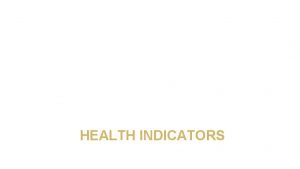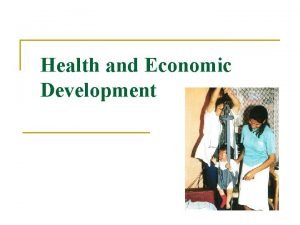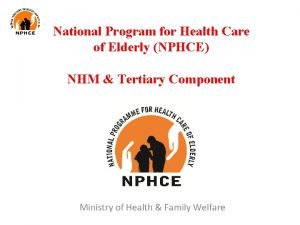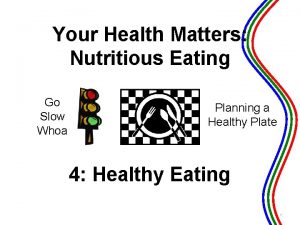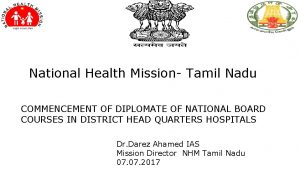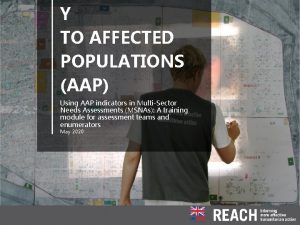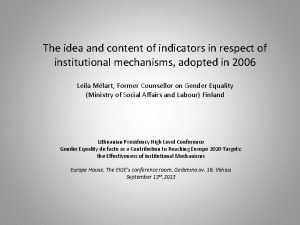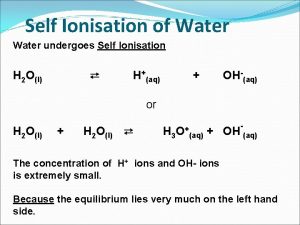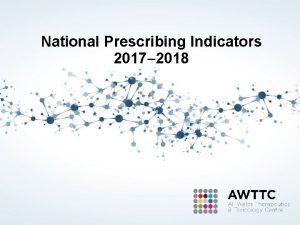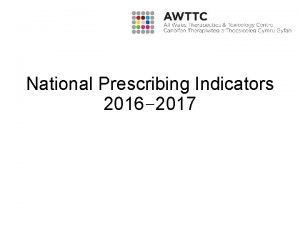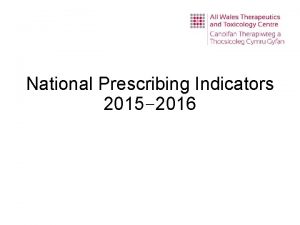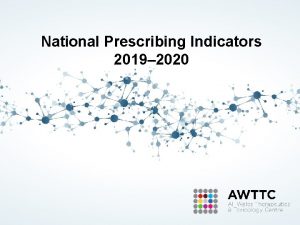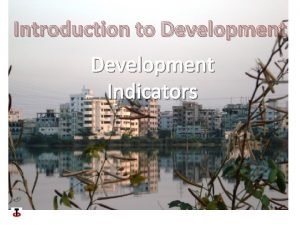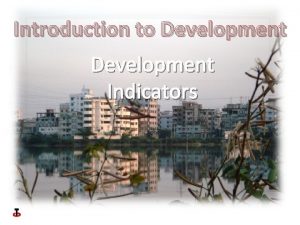HEALTH INDICATORS National Health Indicators Health Health is

















































- Slides: 49

HEALTH INDICATORS National Health Indicators

Health • Health is defined as “a state of complete • • • physical, mental & social wellbeing, and not merely an absence of disease or infirmity” This statement has been amplified to include the ability to lead a “socially and economically productive life” Health cannot be measured in exact measurable forms Measurement have been framed in terms of illness (or lack of health), consequences of illhealth (morbidity, mortality) & economic, occupation & domestic factors that promote ill health

National Health Indicators • Health indicators are used to measure health status of the community. They are defined as parameters that can measure changes in the level of health. In fact, they are indirect parameters or variables that assess state of the health of the community. Indicators can be: 1. Rates 2. Ratios 3. Number (in a specific place and time).

Uses of Health Indicators • Measurement of the health of the community. • Compare health status of one community with • • another whether in the same continent or globally. Assessment of health care needs. Proper allocation of human and non-human resources according to the needs. Monitoring and evaluation of health services, activities, and programs. Compare health status of different areas or groups of people over time.

Characteristics of Indicators 1. Valid: They should actually measure what they are supposed to measure, e. g. use of case fatality rate to measure severity of a disease. 2. Reliable: give similar results when the measure is used for the same person in different times with similar circumstances. 3. Objective: does not depend on subjective feelings of the persons, but depends on defined standards. 4. Sensitive: they should be sensitive to the changes in the measured condition. 5. Specific: only reflects the changes in the measured condition.

Characteristics of Indicators (continued) 6. Feasible: they should have the ability to obtain data needed. 7. Relevant: they should contribute to the understanding of the phenomenon of interest.

Indicators WHO defines Indicators as “variables which measure change”

Health Indicator • A health indicator is a variable that provides a single numeric measurement of an aspect of health within a population for a special period of time, normally a year.

Factors influencing health Indicators • Health is multidimensional • Each dimension is influenced by numerous factors • Economic, occupational, cultural, educational, social

Health Indicators • Mortality indicators • Morbidity indicators • Disability rates • Nutritional status indicators • Health care delivery indicators • Utilization rates • Indicators of social and mental health • Environmental indicators • Socio-economic indicators • Health policy indicators • Indicators of quality of life • Other indicators

Mortality Indicators q. Crude Death Rate (CDR) Number of death per 1000 population during one year. Crude Death rate for Jordan is 5 per 1000 Many of the former Socialist countries of Eastern Europe and Central Asia, Sweden, Switzerland, Austria, Greece, Italy and Germany had a crude death rate (CDR) higher than crude birth rate (CBR), causing a negative population growth if immigration is insufficient to compensate. All other countries had higher birth rates than death rates.

Population Growth Rate • Population Growth Rate: Growth of the population size in one year expressed in percent. • Total Fertility Rate: The number of children that would be born per women if she were to live to the end of the childbearing years and bear children at each age in accordance with the prevailing

Life Expectancy at Birth The numbers of years a newborn baby would live if subjected to present mortality risks prevailing for each age group in the population. • Estimated for both sexes separately. • Good indicator of socioeconomic development • Positive health indicator of long time survival • Life expectancy at birth in Jordan (2013): Total population: Male: Female: 74 71. 6 74. 4 years

Crude Birth Rate (CBR) • CBR is defined as number of births per 1000 • • population during one year. Crude Birth Rate in Jordan is 27 per 1000 population. CBR is dependent on the age structure of the population. A population with a large proportion in the childbearing age naturally has a higher crude birth rate than a population with predominance of either children or people beyond fertile age. The high crude birth rate in Africa arises from the combination of high fertility and a young age structure.

Infant Mortality Rate (IMR) The annual number of children less than one year of age who die per 1000 live birth. Indicator of health status of not only infants but also whole population & socioeconomic conditions. Sensitive indicator of availability, utilization &effectiveness of health care, particularly perinatal care. Current IMR in Jordan is 19 per 1000 live birth

List of the Top and Bottom five countries by IMR • 1. 2. 3. 4. 5. Top countries (High Infant Mortality Rate): Angola 182. 31 Sierra Leone 156. 48 Afghanistan 154. 67 Liberia 143. 89 Niger 115. 42 Bottom countries (Low Infant Mortality Rate): 1. Singapore 2. 30 2. Sweden 2. 75 3. Japan 2. 80 4. Hong Kong 2. 93 5. Iceland 3. 25

The Most Common Causes of Infant Mortality Worldwide 1. Pneumonia 2. Diarrhea (dehydration( 1. 2. 3. Major Causes of Infant Mortality in developed countries include: Congenital Malformation Infection Short Infant death Syndrome (SIDS)

Definition of Childhood Mortality • Infant Mortality: Number of deaths of • • infants one year of age or younger per 1000 live births. Perinatal Mortality: The total number of deaths of the fetus from a gestational age of 22 weeks to the seventh day of life of the newborn. Neonatal Mortality: Only includes deaths in the first 28 days of life. Post-Neonatal death: Only includes deaths after 28 days of life but before one year. Child Mortality: Includes deaths within the first five years after birth.

Child Mortality Rate (Under. Five Mortality Rate) • The annual number of children dying between birth and exactly five years of age, expressed per 1000 live births. • Correlates with inadequate MCH services, malnutrition, low immunization coverage and environmental factors • Current child Mortality rate (Under 5 Mortality Rate) in Jordan is 28 per 1000 Ø Other indicators are Perinatal mortality rate, Neonatal mortality rate, Stillbirth rate, etc. • Correlates with inadequate antenatal care and

Causes of Child Mortality • According to UNICEF most child mortality 1. 2. 3. 4. 5. 6. result from one of the following causes or a combination of: Acute Respiratory Infection (ARI) Diarrhea Malaria Measles Malnutrition Perinatal Disorders

Highest Rates of Child Mortality in the World 1. 2. 3. 4. 5. Sierra Leone Angola Afghanistan Niger Liberia 270 deaths per 1000 260 deaths per 1000 257 deaths per 1000 253 deaths per 1000 235 deaths per 1000

Mortality Indicators q. Maternal Mortality Rate • Number of maternal deaths per year per • 100000 women aged 15 -49 years. (Reproductive Age of women is 15 -49 years). Accounts for the greatest number of deaths among women of reproductive age in developing countries.

Maternal Mortality (Maternal Death) Definition • According to WHO “A maternal death is defined as the death of a women while pregnant or within 42 days of termination of pregnancy, irrespective of the duration and site of the pregnancy, from any cause related to or aggravated by the pregnancy or its management but not from accidental or incidental causes”.

Major Causes of Maternal Death (Maternal Mortality) • According to WHO Report (2005) Major Causes of Maternal Death are: 1. 2. 3. 4. 5. 6. 7. Severe bleeding/hemorrhage (25%) Infections (13%) Unsafe abortions (13%) Eclampsia (12%) Obstructed labor (8%) Other direct causes (8%) Indirect causes (20%), such as malaria, anemia, HIV/AIDS, CVD complicate pregnancy or are aggravated by it.

Maternal Mortality Ratio (MMR) • Number of deaths of women from pregnancy- related causes per 100000 live births. • The MMR is used as a measure of the quality of a health care system. • Measures the risk of death among pregnant and recently delivered women. • Current MMR in Jordan is 38 per 100000 live births. • WHO, UNICEF, and UNFPA Report: The Worst Countries (2003): Sierra Leone (2000), Afghanistan (1900), Malawi (1800), Angola (1700), Niger (1600), Tanzania (1500). Lowest Rates (2005): Iceland (0), Austria (4), USA

Mortality Indicators q. Disease Specific Death Rate Mortality rate which is computed for specific diseases. E. g. TB mortality is 23 per 100000 population per year. q. Proportional Mortality Rate Proportion of all deaths attributed to the specific disease E. g. Coronary heart disease causes 25 to 30 % of all deaths in developed world.

Morbidity Indicators q Morbidity Indicators reveal the burden of ill health in a community, but do not measure the subclinical or inapparent disease states. Incidence • The number of new events or new cases of a disease in a defined population, within a specified period of time. E. g. Incidence of TB is 168 per 100000 population per year. Prevalence • The total number of all individuals who have • • disease at a particular time divided by population at risk of having disease at this point of time Reflects the chronicity of the disease E. g. Prevalence of TB (sputum+ve in

Morbidity Indicators 2. Notification rates is calculated from the reporting to public authorities of certain diseases. yellow fever , poliomyelitis, cholera, plague They provide information regarding geographic clustering of infections, quality of reporting system 3. Attendance rates at health centers. 4. Admission, Readmission and discharge rates. 5. Duration of stay in hospital – reflects the virulence and resistance developed by the etiological factor 6. Absence from work or school. 7. - reflects economical loss to the community Hospital data constitute a basic and primary source of information about diseases prevalent in the community.

Disability Rates q. Sullivan’s Index refers to “expectation of life free of disability”. • Sullivan’s Index = life expectancy of the country -probable duration of bed disability and inability to perform major activities • It is considered as one of the most advanced indicators currently available. q. HALE - Health Adjusted Life Expectancy. • It is based on the framework of WHO • It is based on life expectancy at birth but includes an adjustment for time spent in poor health. • It is the equivalent number of years in full health that a newborn can expect to live based on current rates of ill-health and mortality.

Disability Rates q. DALYs: Disability-Adjusted Life Years. • A comprehensive indicator including both losses • • of healthy years due to disability and premature death. DALYs is an indicator that measures the disease burden in a population, taking into account not only premature mortality but also disability caused by disease or injury. Two things needed to measure DALYs are - Life table of that country, to measure the losses from premature deaths - Loss of healthy life years resulting from disability; the disability may be permanent (polio) or temp (TB, leprosy), physical / mental.

Disability Rates q. Uses of DALYs • • • To assist in selecting health service priorities To identify the disadvantaged groups Targeting health interventions Measuring the results of health interventions Providing comparable measures for planning & evaluating programs • To compare the health status of different countries q DALY express years of life lost to premature death and years lived with disability for the severity of the disability q One DALY is one lost year of healthy life

Disability Rates q. Premature death – defined as one that occurs before the age to which a dying person could have expected to survive if he or she was a member of a standardized mode population with a life expectancy at birth equal to that of world longest surviving population e. g. Japan q. QALY- Quality Adjusted Life Year. • It is the most commonly used to measure the • cost effectiveness of health interventions. It estimates the number of years of life added by a successful treatment or adjustment for quality of life. 32

Nutritional Status Indicators q Nutritional Status is a positive health indicator. q. Newborns are measured for their i. Birth–weight ii. Length iii. Head circumference They reflect the maternal nutrition status q Pre-school children Anthropometric measurements i. Weight – measures acute malnutrition ii. Height – measures chronic malnutrition iii. Mid-arm circumference - measures chronic malnutrition q Growth Monitoring of children q Measuring weight-for-age, height-for-age, weight-forheight, head & chest circumference and mid-arm circumference. Adults Body Mass Index (BMI) is an indicator of Underweight and Obesity. Underweight, Obesity and Anemia are generally considered reliable nutritional

Low Birth Weight • Low Birth Weight: The proportion of newborns with low birth weight is the % of children born with a weight less than 2500 grams.

Growth Monitoring of children (Most Commonly Used Anthropometric Indicators for Children) *Weight-for-age (WFA), Underweight in children. The proportion of underweight in children is the % of children in a specific age group with weight –for- age below -2 SD (standard deviations) of a reference group. *Combines effects on past and present episodes of disease or malnutrition. *Grading: Normal +2 SD to -2 SD Moderate < -2 SD Severe < - 3 SD

Growth Monitoring of children (Most Commonly Used Anthropometric Indicators for Children) • Height-for-age (HFA), stunting in children. • • The proportion of stunting in children is the % of children in a specific age group with height-for-age below -2 SD of a reference group. Integrates effects over whole of life up to age of measurements. Insensitive to acute episodes. Grading: Normal +2 SD to -2 SD Moderate < -2 SD Severe < -3 SD

Growth Monitoring of children (Most Commonly Used Anthropometric Indicators for Children) • Weight-for-height (WFH), wasting in • • children. The proportion of wasting in children is the % of children in a specific age group with weight-for-height below -2 SD of a reference group. Indicates current or recent episodes, insensitive to small but normal proportioned individuals. Grading: Normal +2 SD to -2 SD Moderate < -2 SD Severe < -3 SD

Growth Monitoring of children (Most Commonly Used Anthropometric Indicators for Children) • Mid-upper arm circumference (MUAC): Single • • figure of 16. 5 cm for all children between 1 and 5 years (Reference Standard). It is commonly used as indicator of body shape substituting for BMI in adults and weight –for-Height (WFH) Wasting in children. Indicates current or recent episodes. Fast, cheap, reliable (with careful training). Good predictor of mortality risk. Needs only approximate ages. MUAC Grading: Normal > 13. 5 cm Moderate 12. 5 cm – 13. 5 cm Severe <12. 5 cm

Nutritional Status Indicators (Anthropometrical Indicators) In Jordan q. Nutrition Status Indicators: • Low birth weight: 13% (2007) • Child growth: underweight: 5. 1%, wasting: 2% (2012), Stunting: 8% (2012) • 10 per cent of children aged between five and 18 years are obese. • 33% of women in child bearing age are anemic.

Health Care Delivery Indicators These indicators reflect the equity of distribution of health resources in different parts of the country and of the provision of health care • population per physician 526 • Population – bed ratio 1: 1701 Population per dentist 1747 Population per nurse 324 • Population per pharmacist 1164

HEALTH MANPOWER (Jordan) Registered Doctors Registered Dentists Registered Nurses Population per doctor Population per dentist Population per nurse Population per bed 15000 9000 526 1747 324 1164

Utilization Rates q. Utilization Rates is expressed as the proportion of people in need of a service who actually receive it in a given period, usually a year • It depends on availability & accessibility of health services and the attitude of an individual towards health care system 1. Proportion of infants who are fully immunized 2. Proportion of pregnant women who receive ANC care or have institutional deliveries 3. Percentage of population who adopt family planning 4. Bed occupancy ratio, bed-turn over ratio, etc.

Indicators of Social and Mental Health • Rates of suicide, homicide, other crime, road traffic accident, juvenile delinquency, alcohol and substance abuse, domestic violence etc. • These indicators provide a guide to social action for improving the health of people. • Social and mental health of the children depend on their parents. E. g. Substance abuse in orphan children, smoking

Environmental Indicators • These reflect the quality of physical and • • • biological environment in which diseases occur and people live. The most important are those measuring the proportion of population having access to safe drinking water and sanitation facilities. These indicators explains the prevalence of communicable diseases in a community The other indicators are those measuring the pollution of air and water, radiation, noise pollution, exposure to toxic substances in food and water

Socio-economic indicators • • These do not directly measure health but are important in interpreting health indicators (Jordan). Per capita income: $3425 (upper middle income country by World Bank Classification) GDP (Gross Domestic Product): $35. 83 billions (2014) Level of unemployment 13% Illiteracy rate 9% • • • Poverty Population Total Fertility Rate (TFR) Family size Population increase rate Contraceptive use • • 14. 4% (2010) 6. 6 Millions (2014) 3. 6 5. 8 2. 2% 58%

Health Policy Indicators q. The single most important indicator of political commitment is allocation of adequate resources q. The relevant indicators are • Proportion of GDP spent on health services- 9% • Proportion of GDP spent on health related activities like water supply and sanitation & housing and nutrition • Proportion of total health resources devoted primary health care

Indicators of Quality of Life q. Life expectancy is no longer important q. The Quality Of Life has gained its importance Physical Quality of Life Index • It consolidates Infant mortality, Life expectancy • • at age of 1 yr and Literacy. For each component the performance of individual country is placed on a scale of 1 - 100. The composite index is calculated by averaging the three indicators giving equal weight to each The resulting is placed on the 0 to 100 scale. The PQLI does not consider the GDP.

Indicators of Quality of Life Human Development Index – – – Life expectancy at birth Literacy rate Income- GDP per capita income The result is placed on the 0 to 1 scale

Other indicators Social indicators – Population, families, educational, earning Basic Needs indicators – Calories consumption, access to water, illiteracy, Dr per population Health for All Indicators
 National health programme for children in india
National health programme for children in india National unification and the national state
National unification and the national state Indicator of health
Indicator of health Indicators of health
Indicators of health Community health status indicators
Community health status indicators National health laboratory tanzania
National health laboratory tanzania Nphce program
Nphce program National policy and legislation
National policy and legislation National health policy for children
National health policy for children National core standards in nursing
National core standards in nursing National health programme
National health programme National health programme
National health programme National general 888-781-0585 nc
National general 888-781-0585 nc National health strategy zimbabwe
National health strategy zimbabwe Cambridge national health and social care
Cambridge national health and social care National health information infrastructure
National health information infrastructure National center for disaster medicine and public health
National center for disaster medicine and public health Objectives of community mental health
Objectives of community mental health Go foods
Go foods National health policy 2002
National health policy 2002 Dr. kanupriya chaturvedi
Dr. kanupriya chaturvedi National health mission tamil nadu
National health mission tamil nadu National business group on health conference 2018
National business group on health conference 2018 National rural health mission
National rural health mission Nphce
Nphce National mental health programme
National mental health programme Mike harryman
Mike harryman National children's digital health collaborative
National children's digital health collaborative Health and safety conclusion
Health and safety conclusion Conclusion of national mental health programme
Conclusion of national mental health programme National health planning
National health planning National health information infrastructure
National health information infrastructure National institutes for health
National institutes for health National institute of electronics
National institute of electronics National health systems resource centre
National health systems resource centre Claim bill types
Claim bill types Ocr health and social care
Ocr health and social care Aap indicators
Aap indicators Indicators of potential workplace violence
Indicators of potential workplace violence Theory of indicators
Theory of indicators Language spanish
Language spanish Respect indicators
Respect indicators Lgu scorecard indicators
Lgu scorecard indicators Indicator used in strong acid and weak base
Indicator used in strong acid and weak base Nursing sensitive indicators
Nursing sensitive indicators Tpd in kenya
Tpd in kenya Evaluation indicators examples
Evaluation indicators examples Evaluation indicators examples
Evaluation indicators examples Nonprofit financial dashboard
Nonprofit financial dashboard Treasury kpi metrics
Treasury kpi metrics


